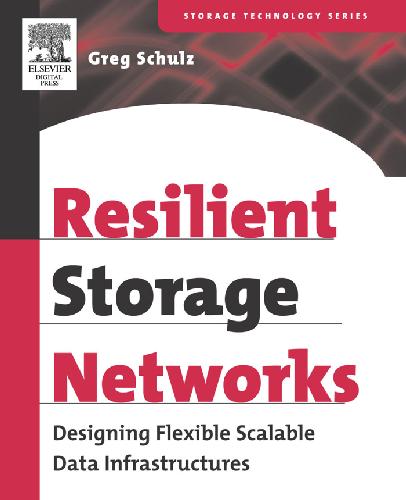Schulz G.1-55558-294-X
Table of contents :
Team DDU……Page 1
Contents……Page 8
Foreword……Page 14
Preface……Page 18
Acknowledgments……Page 22
Part I Why Build Resilient Networks?……Page 24
1.2 Importance and reliability of information……Page 28
1.3 Types of information and data……Page 30
1.4 Information, data, and storage life-cycle management (xLM)……Page 31
1.5 Threats and requirements for data protection……Page 33
1.6 Maintaining information accessibility……Page 36
1.7 Chapter summary……Page 39
2.2 How data is accessed and organized……Page 42
2.3 Chapter summary……Page 51
Part II Networking with Your Storage……Page 54
3.2 Networks and I/O channels……Page 58
3.3 Relationships between enterprise communications and the data center……Page 60
3.4 Enterprise messaging network usage……Page 61
3.5 Deterministic behavior……Page 65
3.6 I/O busses and paths……Page 68
3.7 Data access infrastructures……Page 69
3.8 Accessing storage networks……Page 71
3.9 Network storage interfaces……Page 72
3.10 Networks for storage……Page 74
3.11 Storage and data sharing……Page 78
3.12 Storage networking access models……Page 79
3.13 Chapter summary……Page 88
4.2 Storage networking interfaces……Page 92
4.3 Performance and bandwidth……Page 93
4.4 Storage and I/O interface……Page 94
4.5 Upper-level protocols for storage networking……Page 98
4.6 Storage and networking interfaces……Page 114
4.7 Chapter summary……Page 124
5.2 Fiber-optic essentials……Page 128
5.3 Fiber-optic basics……Page 130
5.4 Fiber-optic cabling types……Page 132
5.5 A word about wavelengths……Page 135
5.6 Fiber-optic connectors and transceivers……Page 136
5.8 Link loss and power budgets (db loss)……Page 140
5.9 Protocol droop……Page 142
5.10 Chapter summary……Page 144
6.2 Metropolitan and wide area networking……Page 148
6.3 Storage over IP for distance……Page 153
6.4 Wave division multiplexing……Page 158
6.6 When to utilize multiplexing……Page 162
6.7 Asynchronous Transfer Mode (ATM)……Page 163
6.8 SONET/SDH……Page 164
6.9 Public switched telephone network……Page 167
6.11 Free space optics and wireless communication……Page 169
6.12 Chapter summary……Page 170
7.2 Storage networking devices……Page 174
7.3 Networking components……Page 194
7.4 Chapter summary……Page 206
Part III Resilient Storage Networks……Page 208
8.2 Getting started……Page 212
8.3 Storage networking design influences……Page 213
8.4 Which type of storage network is right for you?……Page 214
8.5 Know your objectives and requirements……Page 215
8.6 Storage network design……Page 216
8.7 The design process……Page 217
8.8 Chapter summary……Page 242
9.2 Storage networking topologies……Page 246
9.3 Storage network and fabric network……Page 252
9.4 ISL performance topics……Page 261
9.5 Chapter summary……Page 269
10.2 Performance and availability for storage networks……Page 272
10.3 Performance and capacity planning overview……Page 274
10.4 Assessment-determining how what you have is being used……Page 277
10.6 Storage networking performance and capacity concerns……Page 278
10.7 Performance and capacity planning tools and metrics……Page 298
10.8 Storage networking benchmarks and testing……Page 300
10.11 Transaction Processing Performance Council……Page 301
10.12 Chapter summary……Page 302
11.2 Storage networking management……Page 306
11.3 Storage and storage networking management tools……Page 308
11.4 Managing storage and storage networks……Page 313
11.5 Storage Management Interface Specification (SMI-S)……Page 319
11.6 Virtualization and abstraction……Page 321
11.7 Assessing storage management tools……Page 330
11.8 Some general management topics……Page 331
11.9 Chapter summary……Page 332
12.2 Protecting data accessibility……Page 336
12.3 Chapter summary……Page 349
13.2 Storage and storage networking security threats……Page 352
13.3 Securing the storage network……Page 353
13.4 Storage access and allocation security (volume mapping and masking)……Page 354
13.5 Access control lists and policies-securing fabrics, switches, and ports……Page 355
13.6 Security for storage over IP, metropolitan, and wide area interfaces……Page 365
13.7 Virtual fabrics and storage network subnets……Page 366
13.8 Storage networking considerations for servers (processors and hosts)……Page 368
13.10 Chapter summary……Page 371
Part IV Putting It All Together……Page 372
14.2 The small storage network (storage networks for anyone)……Page 376
14.3 Chapter summary……Page 383
15.2 Consolidation of information technology resources……Page 386
15.3 Chapter summary……Page 397
16.2 Metropolitan and wide area storage networks……Page 400
16.3 Chapter summary……Page 407
17.2 Storage and I/O intensive environments……Page 410
17.3 Chapter summary……Page 416
18.2 Review……Page 420
18.3 Some comments and tips……Page 425
18.5 Chapter and book summary……Page 428
Appendix A: Useful Web Sites……Page 430
Appendix B: Resilient Storage Networking Checklist……Page 438
Appendix C: Glossary of Storage Networking Terminology……Page 444
Index……Page 448
About the Author……Page 466







Reviews
There are no reviews yet.